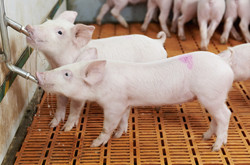Genomics optimises animal breeding
Modern genomics – which has mapped the genomes of the major breeds of livestock – stands on the cusp of revolutionising conventional animal breeding based on selection of desirable traits over generations. These advances have enabled the gradual identification of genes associated with health, welfare, productivity and product quality. The FP7-funded project 'From sequence to consequence - Tools for the exploitation of livestock genomes' (QUANTOMICS)(opens in new window) is moving livestock genomics to a higher level of accurate implementation. Involving 12 leading research groups and 5 companies from across Europe, QUANTOMICS developed, enhanced and integrated tools and technologies to study and understand the function of individual genes in the animal genome; associate the animal genome with their phenotypes and integrate genomic information into successful breeding programmes. QUANTOMICS sequenced the genomes of 18 Finnish Ayrshire and 20 Italian Brown Swiss bulls in order to develop a catalogue of millions of genetic variants in cattle, and developed a pipeline to evaluate their potential effects on animal performance. The team used a mastitis model to demonstrate how the tools work. QUANTOMICS also genotyped 2 500 crossbred commercial broiler chickens to identify specific genes that render individual birds inherently more or less resistant to avian pathogenic Escherichia coli infections, and developed a tool to select for such genes in their purebred parent lines. Quantitative and genomic tools developed by the project are comprehensive in their scope. They enable inclusion of genome-wide selection taking into account the variable number of gene copies within different individuals. Systems developed can also identify genomic features with large effects in a significant number of animals and prioritise the outcomes of identified polymorphisms. The QUANTOMICS project thus bridged the gap between genomic variation and trait differences across a wide range of livestock. The significance to breeding regimes is a quantum leap in effectiveness, achieving the desired improvement with changes in the genome. Across Europe this stands to deliver major increases in animal yield accompanied by improvements in health and welfare. QUANTOMICS also contributed to raising the community awareness on the importance of farmed animal genome annotation. Several of the genomics and bioinformatics scientists brought together in QUANTOMICS subsequently became members of the FAANG consortium(opens in new window), an active working group dedicated to the promotion of a concerted farmed animal genome annotation effort, as outlined in the recently published whitepaper(opens in new window). Details of the tools and their functions can be found on QUANTOMICS tools page(opens in new window). Many of the tools and results are freely available, not least via the Ensemble genome browser(opens in new window), and are expected to have wide application in all farmed species.







